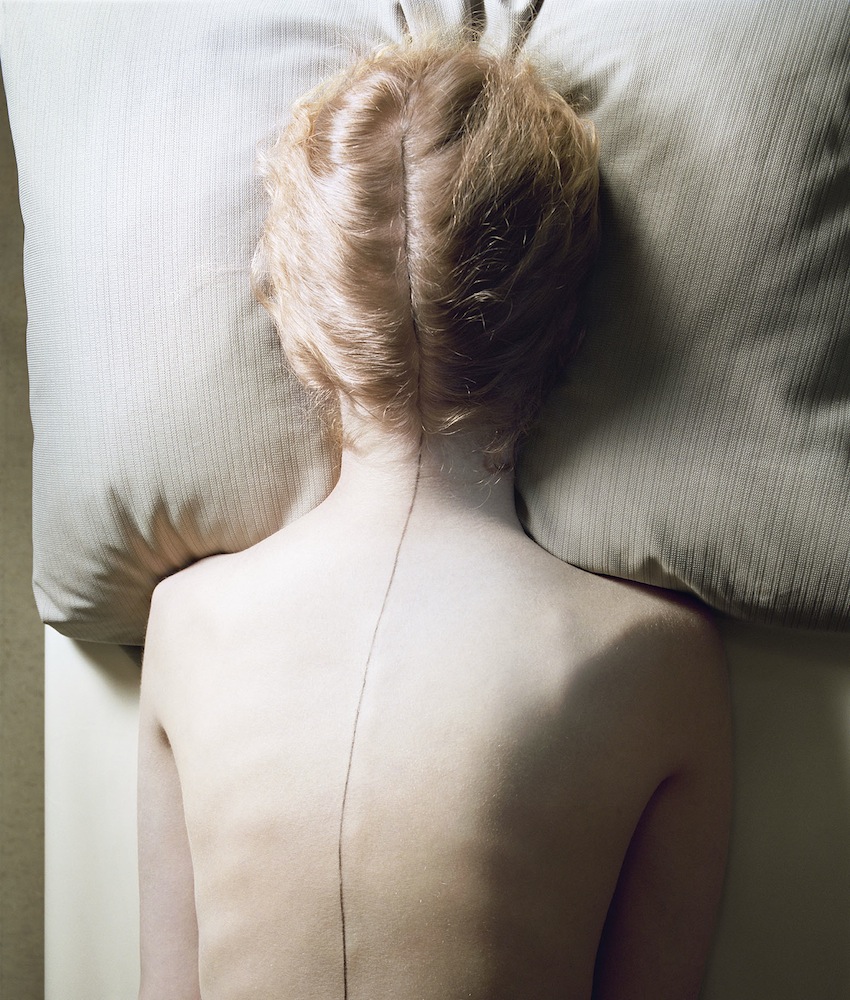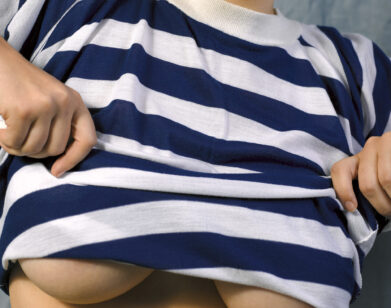Jo Ann Callis: Unknown Pleasures
To hear Jo Ann Callis tell it, she doesn’t really think of herself as a photographer. Or rather, at one point, she didn’t. “I just thought, ‘I make photographs,'” Callis recalls. “I always think of photography as being out there and catching decisive moments and wonderful things that are happening and putting them together by juxtaposition. I never did that.” At some point Callis’ viewpoint changed, and it’s certainly a good thing, because the Ohio-born, L.A.-based artist and early adopter of color photography has been fastidiously making pictures for over 40 years.
Callis’ lavishly saturated Cibachromes of cinematic, painstakingly composed tableaux of food, the body, and everyday objects play with surrealism and tease the subconscious, oftentimes set within the domestic space and dealing with tropes of femininity. Her work Forbidden Pleasures, from the early ’90s series “Cheap Thrills,” is a grid of seductively lit, suggestively anthropomorphic desserts, one of which is a golden-crusted apple pie with a gaping hole in the center, baked juices ready to spill, nestled in a sea of yellow chiffon. Gender and sexuality have been natural themes for Callis, evidenced especially in a series of early color photographs, which she dubbed “her fetish project.”
The majority of these erotically charged photos, produced in the mid-’70s, have never been shown in public, as Callis set them aside as a pet project. The series of anonymous nude female (and a few male) bodies—obscured in milky water, trussed with twine, or posed with tactile materials like sand, honey, duct tape, and fabric—are collected in a new volume, Other Rooms, out June 30 from Aperture, accompanied by an essay from novelist Francine Prose. Callis’ body of work doesn’t just speak to hidden desires; it is also candid and almost unsettlingly sensuous in its fragmented treatment of the body, existing in a detached, dreamlike state of timelessness without definitive context. The works look as if they could have been produced this year.
Callis, a Guggenheim Fellow and longtime professor at CalArts, has exhibited at the Getty Museum and the Whitney Biennial, and currently has a solo exhibition of this series of photographs at Rose Gallery in Santa Monica, entitled “Honey,” on view until August 2. In person, Callis is warm and thoughtful, her eyes alert behind whimsical rimless glasses with cherry-red arms. Interview recently spoke with her at Aperture Foundation in New York.
COLLEEN KELSEY: What is your relationship to this body of work like now, considering it was created nearly 40 years ago?
JO ANN CALLIS: In a good way, I feel a little bit removed. That’s good because I’m not so vulnerable to criticism. But it’s also very gratifying that people are interested in that work. I put it away for a long time, thinking, “It’s early work, and now I’m doing other things,” and I just didn’t think about it showing it to anyone. A couple of them I’ve shown before, but most of them I haven’t. In general, it feels quite wonderful. I think some things just never change, really. I’m in some ways the same person I was then. Of course I’m much older, but certain things are just very basic to one’s personality. I think I have the same interests in my work. The same things appeal to me and there’s a consistency there.
KELSEY: I know you studied various other media, but when did you become more concretely interested in photography?
CALLIS: I was always interested in painting and sculpture as a child, just to make things and paint. But, in 1973 I was at UCLA and I had a course with Robert Heinecken. That changed everything. I really was introduced to photography for the first time, started seeing what could be done, and with his encouragement, I took off from there.
KELSEY: Did you find it to be a freeing medium?
CALLIS: Oh my god, yes. First of all, it doesn’t depend on your ability to draw well and it has its own way of conveying meaning. I’ve never photographed in the street or quickly, on-the-fly. Everything I’ve done has been set up or carefully composed. I like to have that control. So in some ways, there’s the painter in me. A stage designer, maybe. I start with a blank in a way, and then I sort of dress the set.
KELSEY: What was your relationship like with your models, specifically in this group of pictures?
CALLIS: They were either friends or fellow students, or friends or acquaintances. Friends of friends, just like that. I never hired anybody. I would give them a print if anything came out.
KELSEY: I was curious because so many of the images in this book are stripped of identity with the faces obscured or cropped out, and largely anonymous.
CALLIS: Yeah. I really wanted them to be objectified and to be thought of as a body, but any body, and not a specific personality. It’s funny, though. I’m so attracted to looking at faces, and I get to do that so much here in New York because so many people are out on the street and in the subway. It’s such a pleasure. [laughs] I love that. But I don’t make my work about that. [laughs]
KELSEY: Even without a face, the body is probably one of the most interesting forms to look at.
CALLIS: It’s expressive. And they come in so many forms. [laughs] Sometimes they’re androgynous, which is always interesting to me. I love ambiguity. I just didn’t want people to get caught up in the personality.
KELSEY: The nude female form is an archetype that has existed throughout art history—everything from painting to photography to sculpture to—
CALLIS: —Cave painting. Well I was thinking about the Venus of Willendorf today, [laughs] and how far back that goes, maybe even before her, too…
KELSEY: How active were you in repositioning the female form or repurposing it in this body of work, especially because it’s such a canonical trope in, essentially, all of art history? Some female photographers have avoided shooting female nudes because of this tradition, like Collier Schorr in the ’80s. Because of that, she started shooting boys.
CALLIS: Totally. I think once you start clothing the body, then style gets in there, and it has a meaning. I think for this particular group of pictures in Other Rooms, which are somewhat sexual in nature, the nude body stands for that and is vulnerable looking sometimes. I’m thinking of a few pictures who have parts, they’re partially clothed, but… I’ve used male models, too, when I could get them. It isn’t just the female form, but it just felt right. Maybe it’s because we are so used to seeing the female body. Of course, the male gaze and all that it implies, “We’re objectifying women,” and all of those criticisms you could say apply here. But if you carry that to the logical end, then does it mean that it is not politically correct to ever photograph a nude woman? Then you’re falling into that trap of objectification, and I was actually trying to objectify the woman [laughs] and abstract the body too, by harsh light, or colored light. The way they’re printed is using that form. It carries a lot of meaning. I’m just using some of that meaning because it’s well understood. So, I’m using it with my purpose.
KELSEY: Were you at all connected with second-wave feminism in the ’70s?
CALLIS: You know, I was never active in protesting or joining groups. I was busy raising kids and doing my art and going to school in the ’70s, even in the ’60s. I’ve certainly benefited from what the feminists stood for, and of course equality—how could anyone be opposed to that? I’m totally for it. [laughs] But I wasn’t actively participating. I never felt that I was in any way taking advantage of anyone in making those pictures. It was playful; we were having a good time. It was in that spirit. The magic of using photography is you see something in front of you, but you can transform it to mean something else. I enjoyed that kind of magic.
KELSEY: Speaking of magic, how did you settle on the title of Other Rooms? To me it says something about a secret space or a portal or a surreal dimension or something like that, which is something that I think these photographs evoke.
CALLIS. And your inner thoughts that sometimes aren’t even noticed. It hits the other place in your head that you can’t go to. It’s hard to find a title. Actually, a friend suggested that. It was pretty perfect.
KELSEY: Going back to these images’ sexual content, the sensuality is really tactile, and it’s an element that’s multilayered in these photos—something that’s present, but not so overwhelming to the point of distraction at first glance, and really overt the longer you look at them. Were those themes something that was just on your mind, in terms of something to explore, to play with?
CALLIS: Well, it’s always on everyone’s mind. [laughs] I thought I would like to see if I could work with that. It was at a time in my life where that seemed very compelling and also, I had a teacher that was very supportive about that kind of work, so that helped. It was what was going on at that time. Of course there was war and there were other things, but there was the Pill and free love and feminism and all kinds of other things. The morals had changed in the last 15 years, quite dramatically. Women were asserting themselves. I think I was just absorbing it all and feeling my own freedom after a long marriage and going with that wave. [laughs]
KELSEY: When did you usually make your photographs? It seems like you had a lot on your plate with work and your kids.
CALLIS: I know. I was teaching also [at CalArts]. I look back, and I don’t know how I did it. I really don’t. I couldn’t imagine. I made an image called Woman Juggling [1984] and lately I’ve been thinking that’s me again. It was just sort of like, “Can you keep doing all this?” I don’t know! [laughs]
KELSEY: What excited you about using color photography?
CALLIS: I had seen the work of Paul Outerbridge and I could see how he used color as an emotional element. And I thought, “That’s wonderful,” because paintings do that all the time. But when I first learned photography for the first couple years, serious fine art photography was always black and white. But then it was starting to change with [William] Eggleston and the others. But that was street photography and I didn’t think I could make that work for me. But then I saw Outerbridge’s work, and it certainly was working for him, and I thought, “Yeah, this can happen.” You can even tweak the color to give it a certain temperature, and it could be better. That was exciting.
If I look back at all the bodies of work over the many years, there’s a consistency there even though everything looks different from project to project. But there’s still a way I can tell they’re mine. The consistencies are a thought to the formal qualities of the pictures. There’s a certain color scheme that I use a lot, a certain palette. I’m aware of textures and opposing elements that set things off by hot, cool, rough, smooth. I’m also interested in a lot of things that have to do with the home, and that was my environment, but also décor and patterns and fabric. I love fabric. That just keeps coming back no matter how the ideas change. Sensuality, really, I think. And the familiar, tweaking it to have a little edge to it. Both things exist in my reality at the same time.
OTHER ROOMS WILL BE RELEASED FROM APERTURE JUNE 30.







